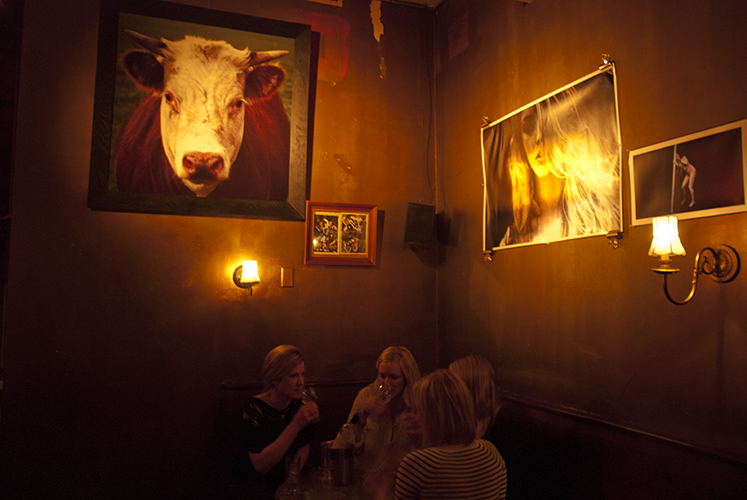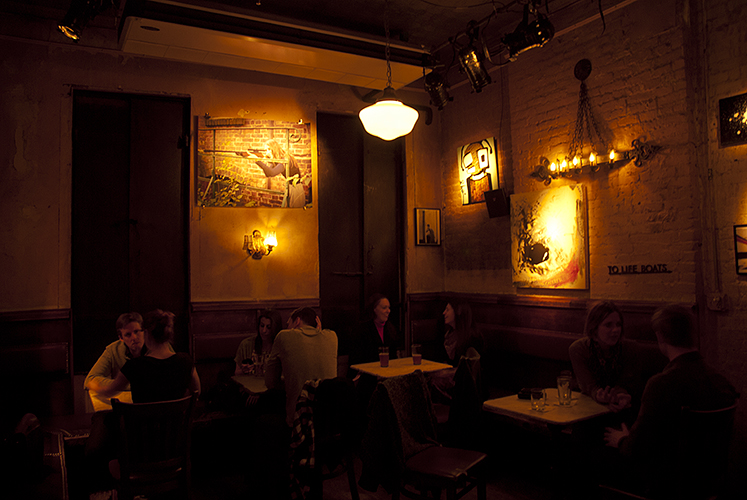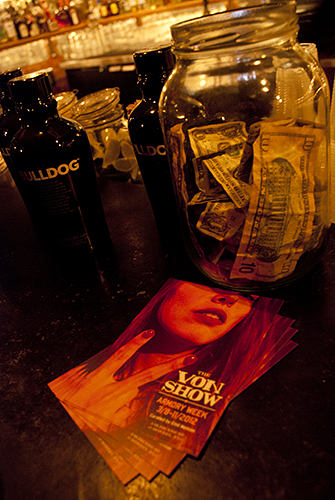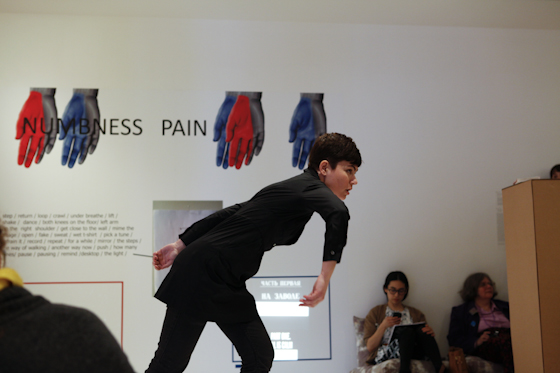The Von Show: even if you never look at art in bars

In a season marked by the Whitney Biennial, with art fairs and benefits for non-profit art organizations in great profusion, with the blandishments of high toned connoisseurship spiced with high octane commerce, with Spring in the air and Winter never really having arrived, with a powerful burgeoning thirst for the eternal verities, what could be better than an art show hung in a local watering hole, an exhibition that hopefully combines the hip with the possibility of a nip?
Such seems to be the rationale of local kneipe VON when they brought in artist/musician/polymath Emil Memon to organize a show during Armory Week. They were not alone in their attempts to end run the business and the busy-ness of art during this crowded moment. VON is down the street from Salon Zurcher, which provided a compact alternative to Armory hoopla by showcasing seven women artists from seven galleries. And VON is just a few blocks from both the Spring/Break "curator-driven art fair" in the Old School at Mott and Prince and also the second edition of BHQF's Brucennial, which gathered the work of 500 artists in a former theater at Bleecker and Sullivan.
Like all of these modest, downtown, indigenous and socially integrated projects, The Von Show happily avers that History is Made at Night. It goes to bat for the home team, but with an international roster of artists that provides an object lesson in "think globally, act locally."
"THE VON SHOW" ARMORY WEEK, NYC, 3/8 - 3/11/2012
Curated by EMIL MEMON
emilmemon@gmail.com
VON/ 3 Bleecker Street, NYC
http://vonshowart.blogspot.com/
Opening reception Thursday, March 8, 7 - 9 PM
Closing reception & party, Sunday March 11, 9 PM - 2 AM
Music performance by APOLLO HEIGHTS, KAREEM BUNTON
DJ/ PIERRE STONE, DJ/GREG POOLE & YINKA

(all photos © Matteo Patocchi, Emil Memon)
ADLER A.F.
ANDREW STRASSER
ALLAN D. HASTY

ALFREDO MARTINEZ

ANTHONY MOLDEN
AMANDA DICKERSON

APOLLO HEIGHTS
BENJAMIN J KELLAY
COLETTE LUMIERE

CHARLES VON HERRLICH
EMIL MEMON
EGON ZIPPEL

GREGORY DE LA HABA

HEIDI SOLANDER
HELEN DENNIS

HESH LEWIS
HYE RIM LEE
IARA CELESTE DIAZ

ISOLDE KILLE

JOHN ENSOR PARKER


JARG GEISMAR

JOSE CASTILLO
JEREMY D. SLATER
JAMES KNIGHT

KONSTANCE PATTON
KAREEM BUNTON
LEWIS STEIN

LESNI JN FELIX
MARK TRIBE
MATEJ MLJAC

MATTEO PATOCCHI
MARCOS MARGALL
PAWEL WOJTASIK

PIA LINDMAN

PIERRE STONE
RAINER GANAHL

RICK PROL

R. SONGE LEE
SIBYLLE SPRINGER

SETH MCBRIDE

VODOO FE
VINOD LANDE
YUKO SUETA
WALTER SALAS HUMARA

Location, location, location. The corner of Bowery and Houston (and even unto Bleecker) is often considered a geographical epicenter of the downtown demimonde, of street cred in the history of the avant garde, sitting at the nexus of SoHo, NoHo, the East Village, and the Lower East Side. But the demise of CBGBs and the Mars Bar has threatened to leave the area without a bastion of funky authenticity.
As the chain stores move in, as generic, interchangeable, upscale boutiques, wine bars and restaurants start to invade the neighborhood, something inevitably gets lost in translation. Even homegrown efforts like Keith McNally's Pulino's flirt with a theme park mentality, the hyperrealization of a pizza place. Mega-grocer Whole Foods establishes another mall of suburban retail food shopping, this time in the belly of the beast; the New Museum's snooty, glittery, ziggurated spaceship lands amid the flophouses and restaurant equipment stores; Sperone Westwater's narrow Norman Foster building seems beamed down, a stranger in a strange land, like the Man Who Fell to Earth, a thin, anemic, extraterrestrial celebrant of high art. As gentrification proceeds apace, there are many locals who could hardly be blamed for muttering under their breath, "there goes the neighborhood". What is left? Where are the true believers going to congregate?

Luckily there are stubborn redoubts like Bob Holman's Bowery Poetry Project and The Hole, Kathy Grayson's art/fashion cynosure established in the wake of Deitch decamping to LA. But for a glimpse of the possibilities of life after the great cleansing, for a tangy, raunchy, roadhouse milieu mixed with the homey virtues of a Euro wine bar/kulturhaus, for the ready imbibing of aesthetics with alcohol, for a certain lingering nostalgie de la boue, there is hardly a better exemplar than VON, an unpretentious saloon defined by sepia tones, exposed brick walls, uneven plank floors (what, no sawdust?), blackboard drink menus, glass cabinets filled with memorabilia, marble tables, recessed banquettes and wine cork ceilings in the basement. We are talking old school to the nth degree, a tavern for adults who have finally gotten serious about their drinking after experimental bouts of collegiate inebriation at Max Fish.

VON was started in 1995, as an antique shop and tea parlor, by Charlotte von Herrlich and her designer/artist brother Charles, but it soon became evident that such an arcane business model would hardly fly in the wild, wooly, wino Bowery of the 1990s. So they got a liquor license, built a bar, and asked some local DJ friends to provide the musical ambiance. The rest, as per the usual phrase, is history.
Then there is the unique and wondrous case of Emil Memon, a Count in his native Slovenia, hailing from the northern Adriatic littoral around Trieste. Memon came to America on a Fulbright in the 1980s and has never looked back. He has adapted to New York's downtown art scene like a MittelEuropa goldfish plopped into the East Village carp pond: swimmingly.
Memon has occasionally organized art exhibitions, in addition to his usual activities as a painter, video artist and musician. In fact, it was his last curatorial effort in November 2011, in conjunction with Adler A.F. and John Ensor Parker, an art happening entitled Hot in a Disco in DUMBO, that directly paved the way for The Von Show. Charles von Herrlich was also in the DUMBO event, and one night, not so very long ago, he and Memon got to talking, over drinks of course, about how VON might greet the upcoming Armory Week.
This fateful late night discussion was scarcely a week before The Von Show commenced, meaning Memon barely had time to sleep as he reached out to friends, associates, and a small group of art world acquaintances to pull together an eclectic and disparate exhibition. Constraints of time and space limit the scope and quality of the show, but there is an undeniable thread of emotional commitment running through it, testament to Memon's obvious enthusiasm and devotion to his artists, as evinced in his curatorial statement:
Emil's Notes:
http://dumbohotdiscoshow.blogspot.com/2011/11/emil-memonhot-in-disco_22.html
this is that show we did in Dumbo in november, here you can see links to works by John Ensor Parker, the guy with the LED light sculpture you talked to,

Adler A.F. she's this incredible German artist, you can see on this blog her performance, i did the video, she had a pair of old boots , that belonged to a worker, I had her boots on a table next to monitors, she has this Art Trash Museum in berlin, she perfumes as Trash Queen, in the photos of the show you can see her assemblage, you can see my work the large drawing of Mishima - project I'm working on right now,
you can see the sculpture by Charles, he co-organized the show with me, all the logistics, i wanted him to have this sculpture in the show he just didn't have time to pick it up, but in a way the basement space he designed is his work that was activated by art and music, the tree trunk is his,
then there's Gregory you can see links to his work on his page.

Sibylle Springer, she is a really good and very dedicated painter, the German woman artist with the gun
http://www.kuenstlerhausbremen.de/sibylle-springer/

This is work by young British artist Helen Dennis, really like her work, its the drawing, black background Sibylle is aiming with her gun
Another similar drawing was in the basement space next to John's light sculpture
www.helendennisart.com
www.helendennis.wordpress.com
some rainer links
http://www.ganahl.info/
http://www.dadalenin.com/
http://www.useabicycle.com/
http://www.ganahlmarx.com/
Pawel W is great video artist long time friend of mine, he was just in New Orleans Biennale with Video work he did on Katrina and New Orleans,
Andrew Strasser is a young performance and video artist, great performer,
Walter S Humara, went to Pratt with him and friend, collaborating on some music, his band The Silos combines and almost creates the genre of mixing underground art rock with country,
Alfredo Martinez is this great larger than life artist, very interesting, the gun painting, same goes for Allan Hasty, the drug bag painting,
Matej Mljac is a Slovenian Architect who did his postgrad at Pratt,
Jeremy Slater i was telling you about, he is involved with Front Room, gallery in Williamsburg,
Matteo is the son of my friend from Switzerland i went to art school with in Florence, he is a fashion photographer in London,
Rick Prol legendary East Village artist from 80's,
Vodoo Fe' the rapper from brooklyn we were talking about his work,
Marcus Margal a long time NYC artist originally from Venezuela, R.onnge Lee video artist,
Egon and Isolde are German painters living, Egon in nyc and Isolde in new mexico, very solid painters.
Pawel Wojtasik
http://www.pawelwojtasik.com/
Isolde Kille
http://www.isoldekille.com/
Lewis Stein
http://www.mmk-frankfurt.de/en/sammlung/werkuebersicht/?kuenstler=166459
Andrew Strasser
http://badbrilliance.com/
http://www.facebook.com/photo.php?v=10150306947235645&set=vb.737695644&type=2&theater
Walter Salas Humara
http://thesilos.net/
http://waltersalashumara.com/newsshows.cfm
Allan D.Hasty
http://www.theproposition.com/wp/allan-d-hasty-biography/
Alfredo Martinez
http://www.theproposition.com/wp/alfredo-martinez-biography/
Jeremy D Slater
http://jeremyslater.net/video.html
Matej Mljac
http://www.matejmljac.com/
Matteo Patocchi
http://www.matteopatocchi.com/
Rick Prol
http://rickprol.com/
Voodo Fe'
http://www.voodofe.com/Voodo_Fe_Culture/Home.html
Marcus Margal
http://www.wanderingprojects.com/mmargall.html
R.Sonnge Lee
http://www.youtube.com/user/imageseries

Music
Apollo Heights
http://www.myspace.com/apolloheights
Yinka


Such seems to be the rationale of local kneipe VON when they brought in artist/musician/polymath Emil Memon to organize a show during Armory Week. They were not alone in their attempts to end run the business and the busy-ness of art during this crowded moment. VON is down the street from Salon Zurcher, which provided a compact alternative to Armory hoopla by showcasing seven women artists from seven galleries. And VON is just a few blocks from both the Spring/Break "curator-driven art fair" in the Old School at Mott and Prince and also the second edition of BHQF's Brucennial, which gathered the work of 500 artists in a former theater at Bleecker and Sullivan.
Like all of these modest, downtown, indigenous and socially integrated projects, The Von Show happily avers that History is Made at Night. It goes to bat for the home team, but with an international roster of artists that provides an object lesson in "think globally, act locally."
"THE VON SHOW" ARMORY WEEK, NYC, 3/8 - 3/11/2012
Curated by EMIL MEMON
emilmemon@gmail.com
VON/ 3 Bleecker Street, NYC
http://vonshowart.blogspot.com/
Opening reception Thursday, March 8, 7 - 9 PM
Closing reception & party, Sunday March 11, 9 PM - 2 AM
Music performance by APOLLO HEIGHTS, KAREEM BUNTON
DJ/ PIERRE STONE, DJ/GREG POOLE & YINKA

(all photos © Matteo Patocchi, Emil Memon)
ADLER A.F.
ANDREW STRASSER
ALLAN D. HASTY

ALFREDO MARTINEZ

ANTHONY MOLDEN
AMANDA DICKERSON

APOLLO HEIGHTS
BENJAMIN J KELLAY
COLETTE LUMIERE

CHARLES VON HERRLICH
EMIL MEMON
EGON ZIPPEL

GREGORY DE LA HABA

HEIDI SOLANDER
HELEN DENNIS

HESH LEWIS
HYE RIM LEE
IARA CELESTE DIAZ

ISOLDE KILLE

JOHN ENSOR PARKER


JARG GEISMAR

JOSE CASTILLO
JEREMY D. SLATER
JAMES KNIGHT

KONSTANCE PATTON
KAREEM BUNTON
LEWIS STEIN

LESNI JN FELIX
MARK TRIBE
MATEJ MLJAC

MATTEO PATOCCHI
MARCOS MARGALL
PAWEL WOJTASIK

PIA LINDMAN

PIERRE STONE
RAINER GANAHL

RICK PROL

R. SONGE LEE
SIBYLLE SPRINGER

SETH MCBRIDE

VODOO FE
VINOD LANDE
YUKO SUETA
WALTER SALAS HUMARA

Location, location, location. The corner of Bowery and Houston (and even unto Bleecker) is often considered a geographical epicenter of the downtown demimonde, of street cred in the history of the avant garde, sitting at the nexus of SoHo, NoHo, the East Village, and the Lower East Side. But the demise of CBGBs and the Mars Bar has threatened to leave the area without a bastion of funky authenticity.
As the chain stores move in, as generic, interchangeable, upscale boutiques, wine bars and restaurants start to invade the neighborhood, something inevitably gets lost in translation. Even homegrown efforts like Keith McNally's Pulino's flirt with a theme park mentality, the hyperrealization of a pizza place. Mega-grocer Whole Foods establishes another mall of suburban retail food shopping, this time in the belly of the beast; the New Museum's snooty, glittery, ziggurated spaceship lands amid the flophouses and restaurant equipment stores; Sperone Westwater's narrow Norman Foster building seems beamed down, a stranger in a strange land, like the Man Who Fell to Earth, a thin, anemic, extraterrestrial celebrant of high art. As gentrification proceeds apace, there are many locals who could hardly be blamed for muttering under their breath, "there goes the neighborhood". What is left? Where are the true believers going to congregate?

Luckily there are stubborn redoubts like Bob Holman's Bowery Poetry Project and The Hole, Kathy Grayson's art/fashion cynosure established in the wake of Deitch decamping to LA. But for a glimpse of the possibilities of life after the great cleansing, for a tangy, raunchy, roadhouse milieu mixed with the homey virtues of a Euro wine bar/kulturhaus, for the ready imbibing of aesthetics with alcohol, for a certain lingering nostalgie de la boue, there is hardly a better exemplar than VON, an unpretentious saloon defined by sepia tones, exposed brick walls, uneven plank floors (what, no sawdust?), blackboard drink menus, glass cabinets filled with memorabilia, marble tables, recessed banquettes and wine cork ceilings in the basement. We are talking old school to the nth degree, a tavern for adults who have finally gotten serious about their drinking after experimental bouts of collegiate inebriation at Max Fish.

VON was started in 1995, as an antique shop and tea parlor, by Charlotte von Herrlich and her designer/artist brother Charles, but it soon became evident that such an arcane business model would hardly fly in the wild, wooly, wino Bowery of the 1990s. So they got a liquor license, built a bar, and asked some local DJ friends to provide the musical ambiance. The rest, as per the usual phrase, is history.
Then there is the unique and wondrous case of Emil Memon, a Count in his native Slovenia, hailing from the northern Adriatic littoral around Trieste. Memon came to America on a Fulbright in the 1980s and has never looked back. He has adapted to New York's downtown art scene like a MittelEuropa goldfish plopped into the East Village carp pond: swimmingly.
Memon has occasionally organized art exhibitions, in addition to his usual activities as a painter, video artist and musician. In fact, it was his last curatorial effort in November 2011, in conjunction with Adler A.F. and John Ensor Parker, an art happening entitled Hot in a Disco in DUMBO, that directly paved the way for The Von Show. Charles von Herrlich was also in the DUMBO event, and one night, not so very long ago, he and Memon got to talking, over drinks of course, about how VON might greet the upcoming Armory Week.
This fateful late night discussion was scarcely a week before The Von Show commenced, meaning Memon barely had time to sleep as he reached out to friends, associates, and a small group of art world acquaintances to pull together an eclectic and disparate exhibition. Constraints of time and space limit the scope and quality of the show, but there is an undeniable thread of emotional commitment running through it, testament to Memon's obvious enthusiasm and devotion to his artists, as evinced in his curatorial statement:
The VON/Armory show was organized by Emil Memon and Charles Von Herrlich, Emil as a curator and Charles providing logistics. Because the show was produced in a very short time, the curatorial driving force was the personal connection the curator had with each individual artist and musician that participated in the show. Since creativity is the driving force for all involved, their lives crossed paths at one or another point, sort of organically and logically. This curatorial approach to the show made it very open and democratic. Artists in it are diverse as persons, in the type of work they are producing, and where they are in their professional careers; in a way it's a very politically correct selection. One interesting fact about this show, as it was done in a very compressed time, is that it would have been impossible to organize it even two years ago, since the social media and smart phone physically made it possible.
Emil's Notes:
http://dumbohotdiscoshow.blogspot.com/2011/11/emil-memonhot-in-disco_22.html
this is that show we did in Dumbo in november, here you can see links to works by John Ensor Parker, the guy with the LED light sculpture you talked to,

Adler A.F. she's this incredible German artist, you can see on this blog her performance, i did the video, she had a pair of old boots , that belonged to a worker, I had her boots on a table next to monitors, she has this Art Trash Museum in berlin, she perfumes as Trash Queen, in the photos of the show you can see her assemblage, you can see my work the large drawing of Mishima - project I'm working on right now,
you can see the sculpture by Charles, he co-organized the show with me, all the logistics, i wanted him to have this sculpture in the show he just didn't have time to pick it up, but in a way the basement space he designed is his work that was activated by art and music, the tree trunk is his,
then there's Gregory you can see links to his work on his page.

Sibylle Springer, she is a really good and very dedicated painter, the German woman artist with the gun
http://www.kuenstlerhausbremen.de/sibylle-springer/

This is work by young British artist Helen Dennis, really like her work, its the drawing, black background Sibylle is aiming with her gun
Another similar drawing was in the basement space next to John's light sculpture
www.helendennisart.com
www.helendennis.wordpress.com
some rainer links
http://www.ganahl.info/
http://www.dadalenin.com/
http://www.useabicycle.com/
http://www.ganahlmarx.com/
Pawel W is great video artist long time friend of mine, he was just in New Orleans Biennale with Video work he did on Katrina and New Orleans,
Andrew Strasser is a young performance and video artist, great performer,
Walter S Humara, went to Pratt with him and friend, collaborating on some music, his band The Silos combines and almost creates the genre of mixing underground art rock with country,
Alfredo Martinez is this great larger than life artist, very interesting, the gun painting, same goes for Allan Hasty, the drug bag painting,
Matej Mljac is a Slovenian Architect who did his postgrad at Pratt,
Jeremy Slater i was telling you about, he is involved with Front Room, gallery in Williamsburg,
Matteo is the son of my friend from Switzerland i went to art school with in Florence, he is a fashion photographer in London,
Rick Prol legendary East Village artist from 80's,
Vodoo Fe' the rapper from brooklyn we were talking about his work,
Marcus Margal a long time NYC artist originally from Venezuela, R.onnge Lee video artist,
Egon and Isolde are German painters living, Egon in nyc and Isolde in new mexico, very solid painters.
Pawel Wojtasik
http://www.pawelwojtasik.com/
Isolde Kille
http://www.isoldekille.com/
Lewis Stein
http://www.mmk-frankfurt.de/en/sammlung/werkuebersicht/?kuenstler=166459
Andrew Strasser
http://badbrilliance.com/
http://www.facebook.com/photo.php?v=10150306947235645&set=vb.737695644&type=2&theater
Walter Salas Humara
http://thesilos.net/
http://waltersalashumara.com/newsshows.cfm
Allan D.Hasty
http://www.theproposition.com/wp/allan-d-hasty-biography/
Alfredo Martinez
http://www.theproposition.com/wp/alfredo-martinez-biography/
Jeremy D Slater
http://jeremyslater.net/video.html
Matej Mljac
http://www.matejmljac.com/
Matteo Patocchi
http://www.matteopatocchi.com/
Rick Prol
http://rickprol.com/
Voodo Fe'
http://www.voodofe.com/Voodo_Fe_Culture/Home.html
Marcus Margal
http://www.wanderingprojects.com/mmargall.html
R.Sonnge Lee
http://www.youtube.com/user/imageseries

Music
Apollo Heights
http://www.myspace.com/apolloheights
Yinka























